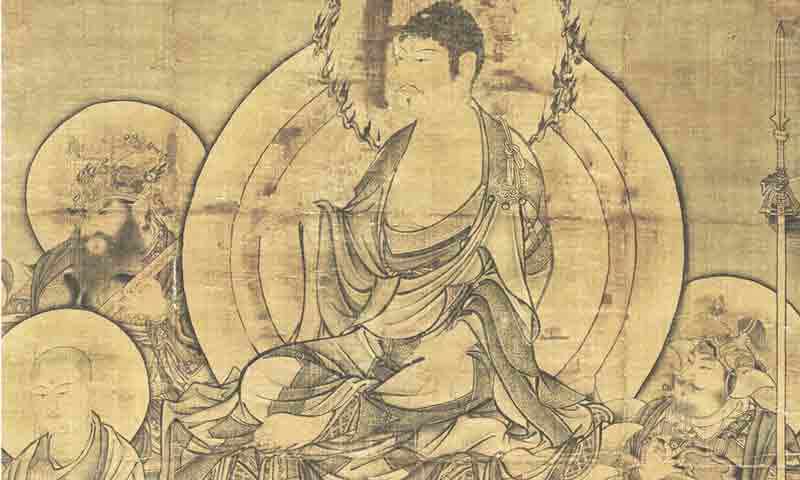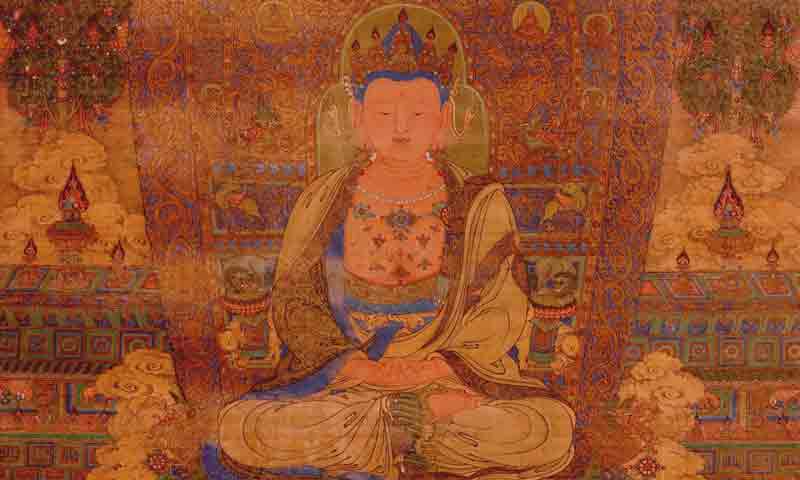
Chinese Buddhism - An Overview

A Buddhist Drawing From China
This article provides a brief history of the origin, development and decline of Buddhism in China and Chinese Buddhist Schools
Buddhism entered China a few centuries after the passing away of the Buddha, at a time when Confucianism and Taoism were the predominant religions in a country that was as a big as a continent and rivaled India in historical antiquity and cultural pluralism. In the early phases of its entry, Buddhism did not find many adherents in China. However, by the 2nd Century AD, aided to some extent by the simplicity of its approach and some similarities with Taoism, it managed to gain a firm foothold and acquired a sizeable following.
The earliest interaction between China and Buddhism happened in the early 3rd Century BCE, when Indian monks travelled to the capital of China in Shen-si to propagate the faith. In the subsequent centuries there were further interactions as more monks and religious texts reached China along the Silk Road and by land and sea from India and Sri Lanka. As a result, by the fifth century C.E., Buddhism was a well-established religion in mainland China and adjoining territories.
During this period, many texts were translated from Pali into Chinese, contributing to a flowering of Buddhist thought and emergence many Buddhist schools. They were distinctly Chinese in character, although they were derived from the translations of original Pali and Sanskrit texts brought from outside the country. The arrival of many new Buddhist scholars from the Indian subcontinent and central Asia, like An Shih-Kao, a Parthinian monk, and Lokakshema, a Kushana monk from Central Asia gave an impetus to the new religion that had many attractive features besides an inbuilt organizational approach to the study and pursuit of religion.
The collapse of Han dynasty around 220 AD, was followed by a period of confusion which continued to trouble Chinese society for the next 350 years. During this period Confucianism and Taoism gradually yielded place to Buddhism. The new Mongolian rulers of China from the Northern Wei dynasty and some rulers in the south like Emperor Wu found in Buddhism a great opportunity to demolish the old order and establish a new one. As a result, by 6th Century AD, China was a predominantly Buddhist country, with numerous Buddhist monks and monasteries enjoying royal patronage and support from local lords.
During this transformative period, two major developments took place in Chinese Buddhism. One group consisting mostly of the sophisticated gentry dwelled on the philosophical and mystical aspects of Buddhism, while the other group dominated by rural folk followed Buddhism in their own superstitious and simple ways imparting to it in the process a peculiar Chinese Character.
The period also witnessed the arrival of many Buddhist monks and scholars from the Indian subcontinent. They brought with them their insight into Buddhist beliefs and practices and contributed richly to the development of Buddhism as the official and most popular religion of China. Notable among them were scholars like Dharmaraksha (3rd Century AD) Kumarajiva (4th Century AD), who got a number of Buddhist texts translated into Chinese. By this time China produced its own eminent Buddhist scholars with extraordinary vision like Seng-Chao, Tao-Sheng and Fa-hsien who also contributed richly to the growth of Chinese Buddhism through their translations.
From the 6th Century AD until the10th Century AD China was ruled by Sui and T'ang dynasties who were also patrons of Buddhism. During this period Chinese Buddhism reached its glorious height. At the same time the decline also began. Many Buddhist monasteries turned to profit making ventures to support their activities. They indulged in materialistic occupations such as farming, trading, pawn brokering and money lending Using slave labor and low-ranking monks, they cultivated farm lands, operated mills and oil presses. They also hoarded wealth as metals and precious stones.
The decline of Chinese Buddhism began during the reign of a Chinese Emperor Wu-Tsung (841-847). Probably noticing the greed that characterized many monasteries, he ordered for the general destruction of all Buddhist establishments and return of all Buddhist monks and nuns to lay life. His actions greatly weakened the foundations of Buddhism, though it did not completely destroy it. Emperor Wu dismantled many monasteries and transferred the wealth they hoarded to his own treasury. He was chiefly responsible for the reversal of Buddhism in China and contributed to its decline. As a result, from the 11th Century onwards, China witnessed the reemergence of Confucianism and revival of people's interest in their traditional beliefs. The decline in the moral and ethical practices of Buddhist monasteries contributed to the new development.
During the same period, Buddhism faced newer challenges in India from native traditions (Hinduism). The invasion of Islamic rulers and establishment of an Islamic empire in India hastened the decline. These developments from India had a direct impact upon the fortunes of Buddhism in China, since for a long time India served as a fountain of knowledge and inspiration for Chinese Buddhism. The decline led to the lowering of standards in the recruitment of monks and the emergence of decadent schools of Buddhism. They deviated from the Eightfold Path and the original monastic discipline as prescribed by the traditional texts (Vinaya) and focused more upon exploring the lighter side of life for the mitigation of suffering. The emergence of Pu-Tai, or the Laughing-Buddha was one such development. Many consider him to be a decadent version of the exalted and highly revered Maitreyi Buddha.
The Yuan dynasty, which came to power in 1280 adopted Lamaism as their state religion. It was the Tibetan version of Buddhism which gained ascendance in the mountainous country, following the emergence of Vajrayana Buddhism in eastern India. During this period, several secret schools of Buddhism were founded in China. They believed in the appearance of a future Maitreya Buddha and the emergence of a new world order. These schools practiced martial arts such as Kungfu and indulged in the political matters of local warlords who patronized them.
Although Chinese Buddhism lost its dynamism and vibrancy by the beginning of the 20th century, it continued to flourish in China in the first few decades. The fall of Quing dynasty in 1917 ended whatever patronage the Sangha received. The properties of many monasteries passed on into the hands of government, military and public institutions for secular use. Efforts were made by a few Buddhist monks such as Taixu (1890-1947) to revive the tradition, but whatever hope Buddhism had in China ended with the rise of Communism and the establishment of Communist Government. The developments which followed the communist revolution ended the practice of not only Buddhism but all other faiths. The Chinese government abolished all forms of public worship and closed down all the monasteries.
The cultural revolution of Communist China ended whatever hopes and possibilities monks had for the revival and continuity of the Dharma and Sangha. Today Chinese Buddhism is a relic of its past, an ancient monument that has been ravaged by time, class conflicts, social reengineering and ideological notions. It is difficult to say how long it would take for the cycle of Dhamma to regain its supremacy, and whether it would ever happen at all.
 A rare painting of the Buddha from 15th Century China, Ming Dynasty
A rare painting of the Buddha from 15th Century China, Ming Dynasty
Chinese Schools of Buddhism
The Buddhism which emerged in China has a distinct flavor of its sociopolitical growth and development. Tradition recognizes at least ten prominent schools of Chinese Buddhism. These schools flourished a long time ago. Some of them are still be existing, but they are not well known. The one which are existing might have undergone change due to the assimilation of the tenets and practices of other schools. For example, the Vinaya school does not exist now, but is practices have been incorporated by others
The principal schools of Buddhism which flourished in China were:
1. The Vinaya School (Lu-tsung)
2. The Realistic School (Chu-she)
3. The Three Treatises School (San-lun)
4.The Idealist School (Fa-hsiang)
5. The Mantra or Tantric School (Mi-tsung or Chen-yen)
6. The Avatamsaka or Flower Adornment School (Hua-yen)
7. The T'ien-t'ai or White Lotus School (Fa-hua)
8. The Pure Land School (Ching t'u)
9. The Dhyana School (Ch'an)
10. The Satyasiddhi School (Cheng-shi, Japanese Jojistus)
End
For a detailed account of the ten schools of Chinese Buddhism please check this article.
Suggestions for Further Reading
- A Comprehensive History of Chinese Buddhism
- Buddhism - The Concept of Anatta or No Self
- Anatta or Anatma in Buddhism
- Anicca or Anitya in Buddhism
- The Buddha on God
- The Buddha on Avijja or Ignorance and on the Origin of Life
- The Buddha On the Self And Anatta, the Not-Self
- History Of The Four Buddhist Councils
- The Eightfold Path Of Buddhism
- The Four Noble Truths of Buddhism
- Four Stages of Progress on the Middle Way in Buddhism
- The Practice of Friendliness, Kalyanamittata, in Buddhism
- Karma or Kamma In Buddhism
- Mahayana Buddhism
- Buddha's Last Days and Final Words
- Buddhism - The Middle Way
- The Buddha's Teaching on Right Mindfulness
- The Meaning and Practice of Mindfulness
- Buddhism - Vinaya or Monastic Discipline
- Right Conduct For Lay Buddhists
- Nirvana or Nibbana in Buddhism
- Buddhism - Objects of Meditation and Subjects for Meditation
- Buddhism - Right Speech and Mind Training
- Buddhism - Right Living On The Eightfold Path
- Handbook for the Relief of Suffering by Ajaan Lee
- Theravada Buddhism
- Meat Eating or Vegetarianism in Buddhism
- Essays On Dharma
- Esoteric Mystic Hinduism
- Introduction to Hinduism
- Hindu Way of Life
- Essays On Karma
- Hindu Rites and Rituals
- The Origin of The Sanskrit Language
- Symbolism in Hinduism
- Essays on The Upanishads
- Concepts of Hinduism
- Essays on Atman
- Hindu Festivals
- Spiritual Practice
- Right Living
- Yoga of Sorrow
- Happiness
- Mental Health
- Concepts of Buddhism
- General Essays
Image Attribution: The images of the Buddha used in this article are either in public domain or licensed under the Creative Commons Attribution-Share Alike 3.0 Unported license.